| HOME |
|---|
CASSIOPEIA
The Queen
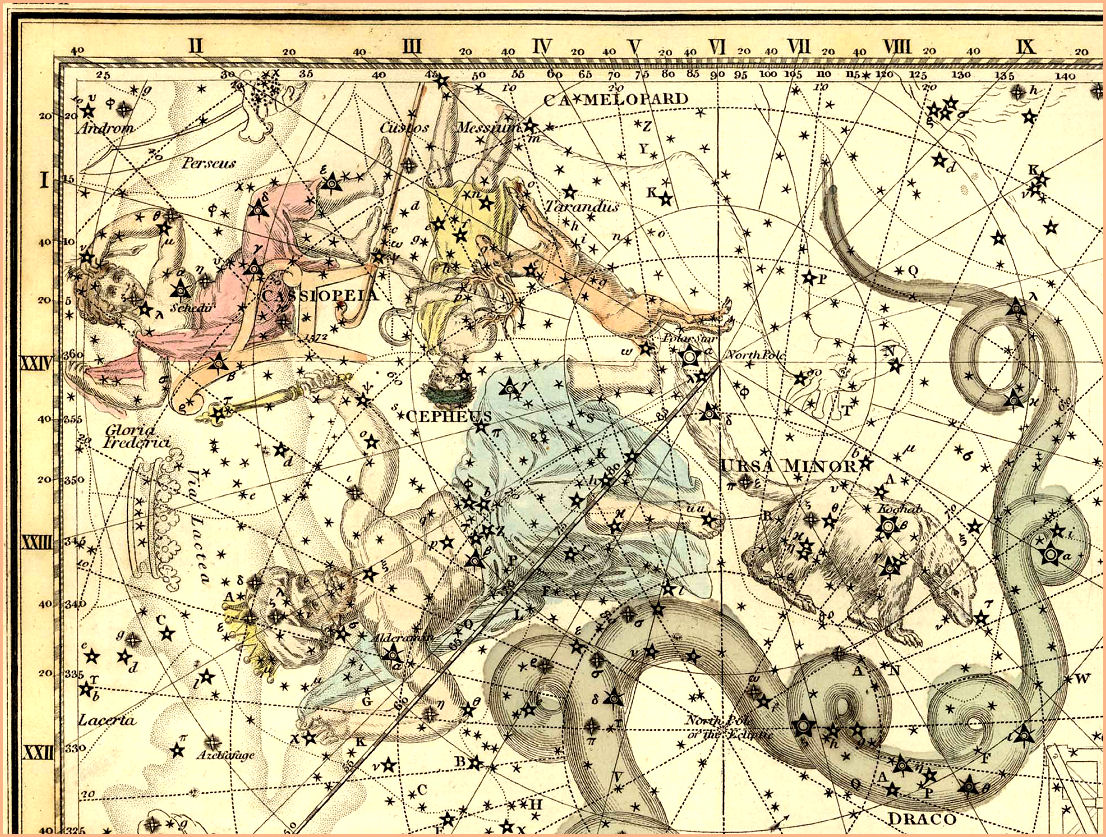
Cassiopeia - Celestial Atlas by Alexander Jamieson - 1822
| HOME |
|---|

After the Big Dipper, the most recognizable grouping of stars in the northern sky has to be the big bright "W" of Cassiopeia. Nestled securely in the heart of the Milky Way, Cassiopeia is the queen who's arrogance started all the trouble in the Andromeda Saga, that ultimately gave birth to the six most prominent constellations in the Autumn sky. The queen, surrounded by her royal family, is usually depicted sitting on a throne. To early Arabs, she was "Al Dhat al Kursiyy", the lady in the chair.
(Jamieson's depiction above includes two constellations that are now obsolete. Custos Messium, the harvest keeper (purportedly an homage to Charles Messier, the comet "harvester"), and Tarandus, the reindeer. Both constellations were added by French astronomers in the eighteenth century, but did not make the cut in 1930, when the International Astronomical Union officially sanctioned the 88 constellations we use today.)
Cassiopeia is a circumpolar constellation that circles the north star (Polaris), and never sets below the horizon for viewers above 35 degrees north latitude. This means our queen spends half her time lying on her back as a big "M" above the pole, and half her time face down in the familiar "W" form when she is below the pole. This apparently is no accident, for unlike most other constellation personas, the queen was not placed in the sky as an act of praise and reward, but of chastisement and punishment. As R.H. Allen tells us,
"Hyginus... described the figure as bound to her seat, and thus secured from falling out of it in going around the pole head downward, — this particular spot in the sky having been selected by the queen's enemies, the sea-nymphs, to give her an effectual lesson in humility, for a location nearer the equator would have kept her nearly upright."
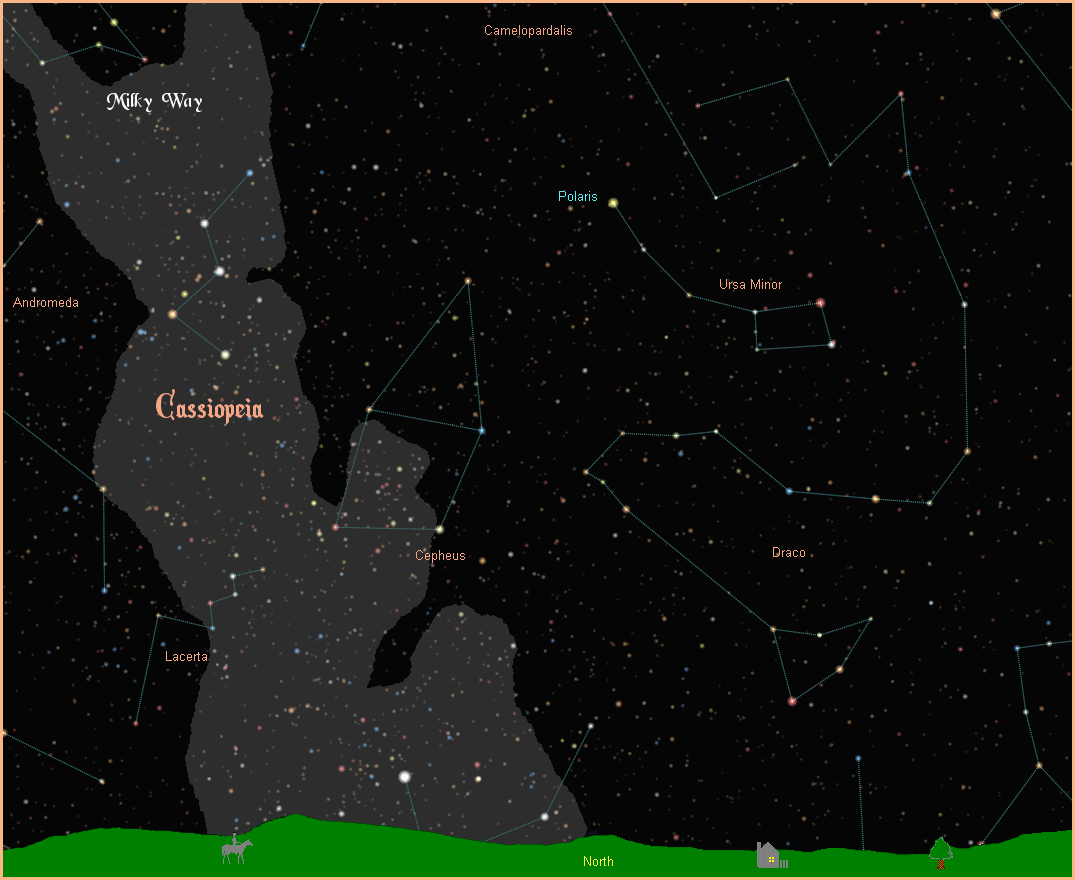
The alpha star in the constellation is named Shedir, from the Arabic for breast, which appears to be anatomically correct. At magnitude 2.24 it is the brightest star in the constellation. Classified as a K0III orange giant, it is 230 light years away.
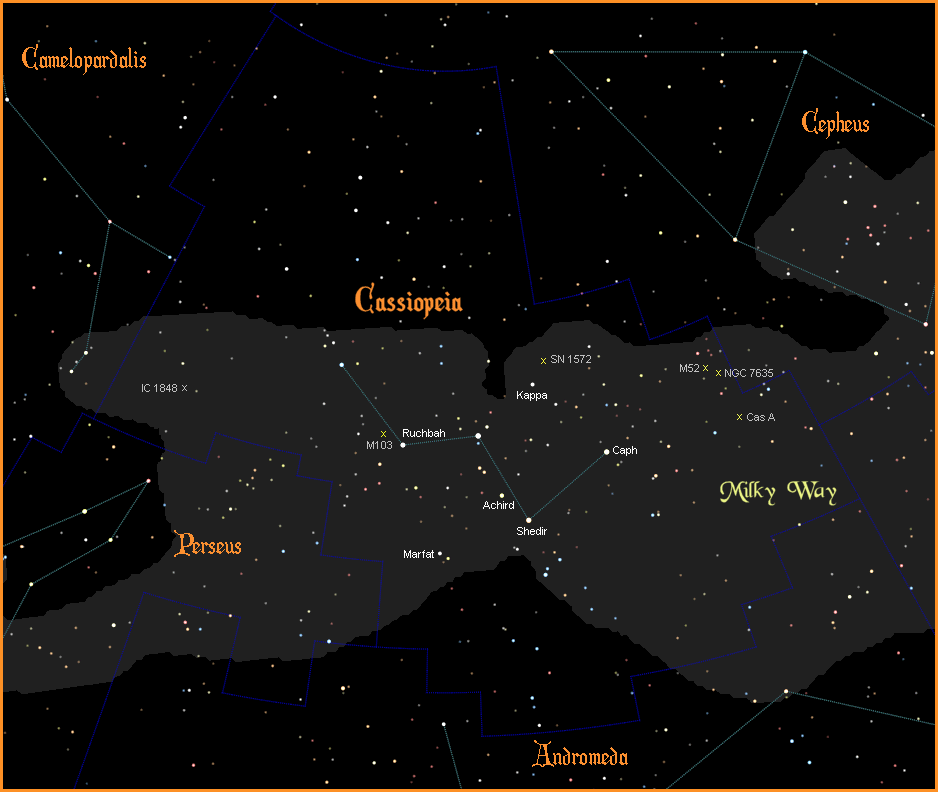
Beta Cassiopeiae is Caph, the Arab name for the queen. It marks the upper right side of the chair, and at magnitude 2.28 it is the second brightest star. Classified as an F2III yellow giant, it is 55 light years away. It is also classed as a "Delta Scuti Variable", with a small but regular dip in brightness that occurs every 2.5 hours.
Delta Cassiopeiae has the name Ruchbah, from the Arabic for knee, right where it should be. Classified as an A5IV white subgiant, the star has a magnitude of 2.68, and is 100 light years away.
Eta Cassiopeiae is named Achird, and no-one knows why. It's not part of the famous "W", it's not very bright (magnitude 3.44), and no-one knows what the name means. It is a binary system quite close to Earth, only 19 light years away, and the primary star is almost a duplicate of our Sun. It is a G0V yellow main sequence star with almost exactly the same mass, radius, and surface temperature of our Sun. Unlike our Sun, it has a companion, an eighth magnitude K7 orange main sequence star about half its size, that orbits every 480 years.
Another named star that's not part of the "W" is Theta Cassiopeiae, named Marfak, from the Arabic for elbow, which it represents. It is an A7 white main sequence star, magnitude 4.3, about 137 light years away.
Right beside Marfak is Mu Cassiopeiae, also named Marfak. Somewhat confusing perhaps, although to be fair the good queen does have two elbows. This elbow is much closer and dimmer, only 24 light years away, and magnitude 5.2. It is a K1V yellow/orange main sequence star, with a small, twelfth magnitude companion, making it a binary system.
Cassiopeia also contains a giant rogue star, known as Kappa Cassiopeiae, that is causing a lot of commotion. It is a B1I blue supergiant, a true behemoth, 40 times larger and four times hotter than our Sun. It is a star on its way to becoming a supernova. It is also moving in a different direction than all the other stars at a speed of 2.5 million miles per hour (1,100 kms/second). As shown in the NASA photo below, the star is creating a massive bowshock as it plows through the interstellar medium of gas and dust. Fortunately for us, all of this is happening very far away, at a nice, safe distance of 4,000 light years. Even at that great distance it still has a magnitude of 4.20 and is easily visible to the naked eye. Not part of the queen's "W" body, the star traditionally represents her throne.
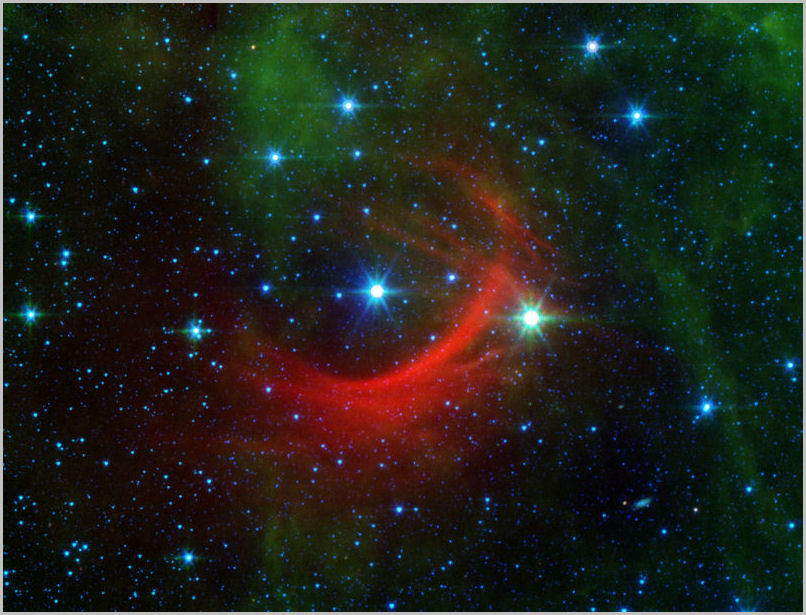
There are eight stars with planetary systems discovered so far in the constellation Cassiopeia. The stars are all very far away, and beyond naked eye visibility, and the planets are all gas giants. For more information on these and other extrasolar planets, visit NASA's New Worlds Atlas, and The Open Exoplanets Catalogue.
Like a true queen, Cassiopeia is surrounded by jewels, in this case the myriad star clusters and nebulae that fill the middle of the Milky Way. On one side, like a sparkling cluster of diamonds, we find the dense grouping, M52 (NGC 7654), consisting of 193 stars. A good telescope target at magnitude 6.9, the cluster is about 35 million years old, and estimated to be about 5,000 light years away.
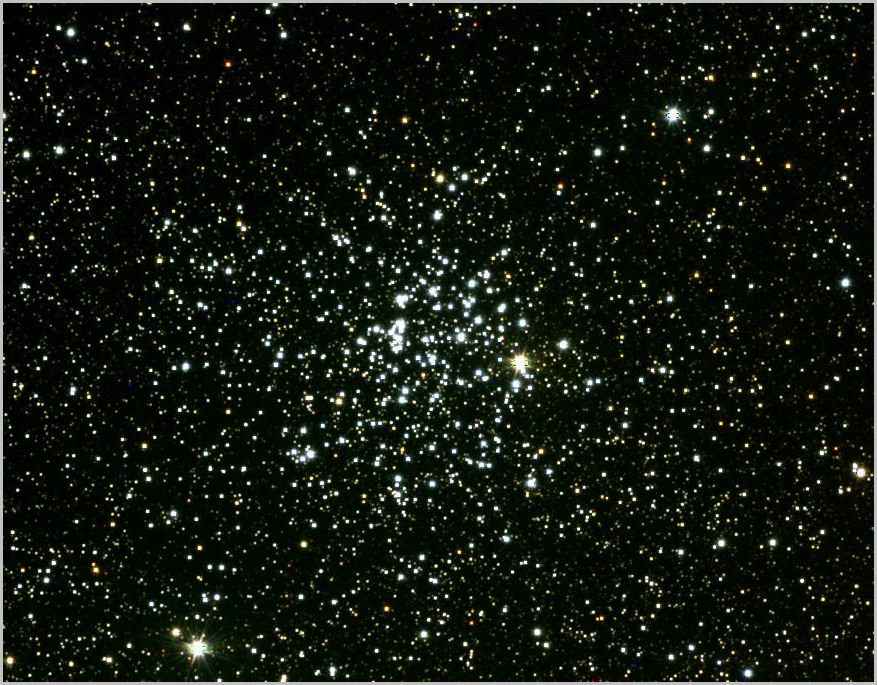
On the queen's other side, like a gem studded bracelet, is the loose, colorful star cluster M103 (NGC 581). This grouping consists of 39 hot, blue-white stars, with one enormous, much cooler red giant in the middle. The stars are about 20 million years old, and very far away at a distance of 8,000 light years. With a magnitude of 7.4, the cluster is a fine sight in a small scope.
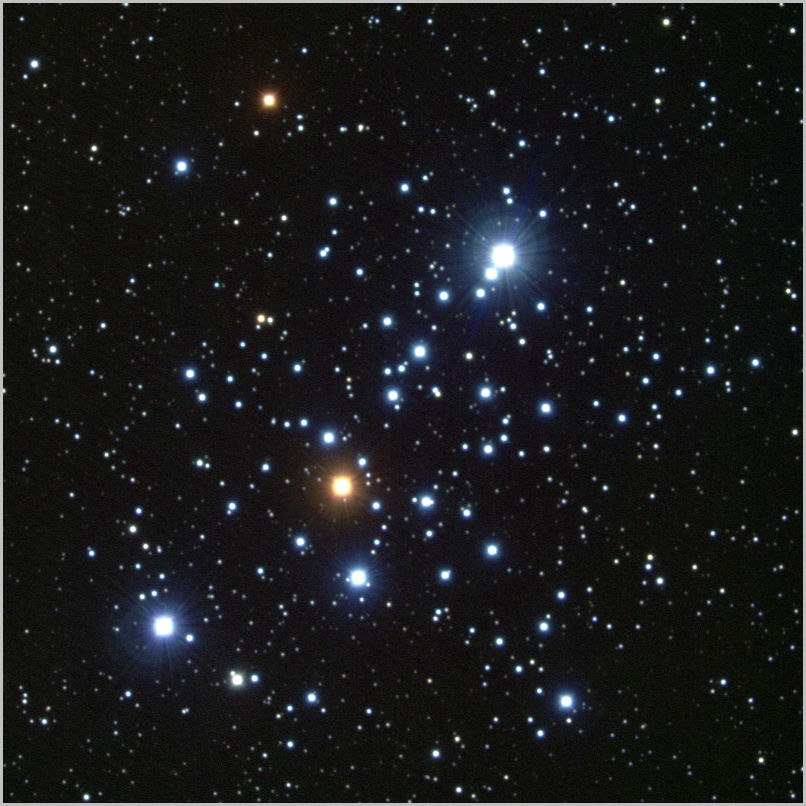
Like the Orion Nebula, (M42), the Heart and Soul Nebula is a vast cloud of gas and dust where stars are being born. Below left is the Soul Nebula, IC 1848, also known as the Embryo Nebula, and W5. Below right is IC 1805, the Heart Nebula.
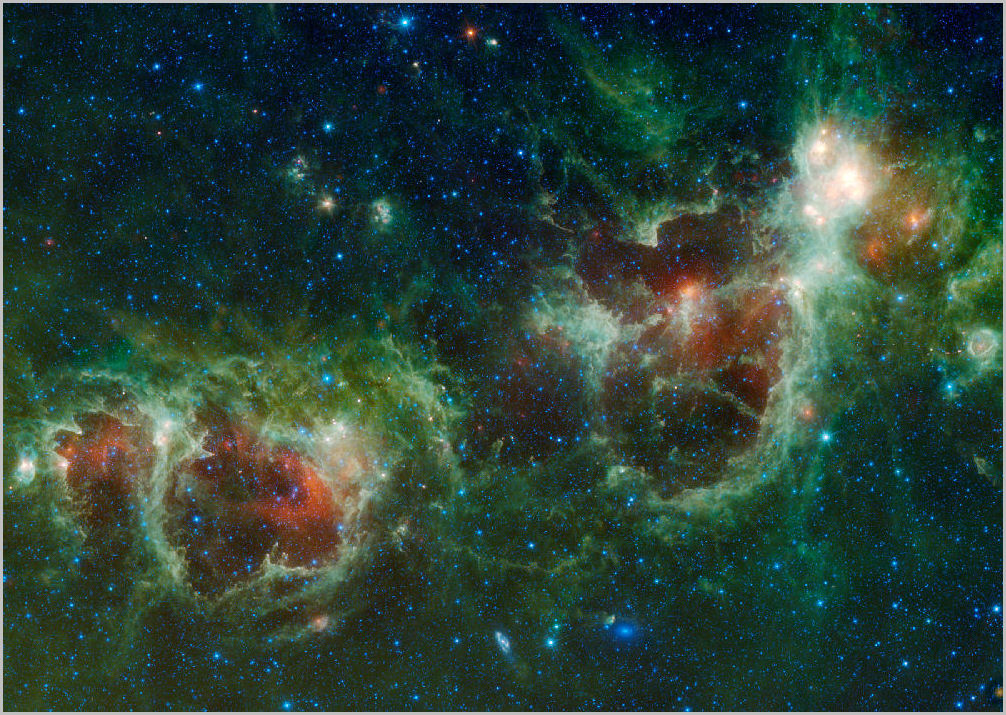
About 7,100 light years away is NGC 7635, magnitude 11.0, also known as The Bubble Nebula. It is a shell or bubble of expanding gas 7 light years in diameter, shed from a super massive, dying star that will one day end its life in a supernova explosion. The bubble of gas is expanding outwards at a speed of 4 million miles per hour.
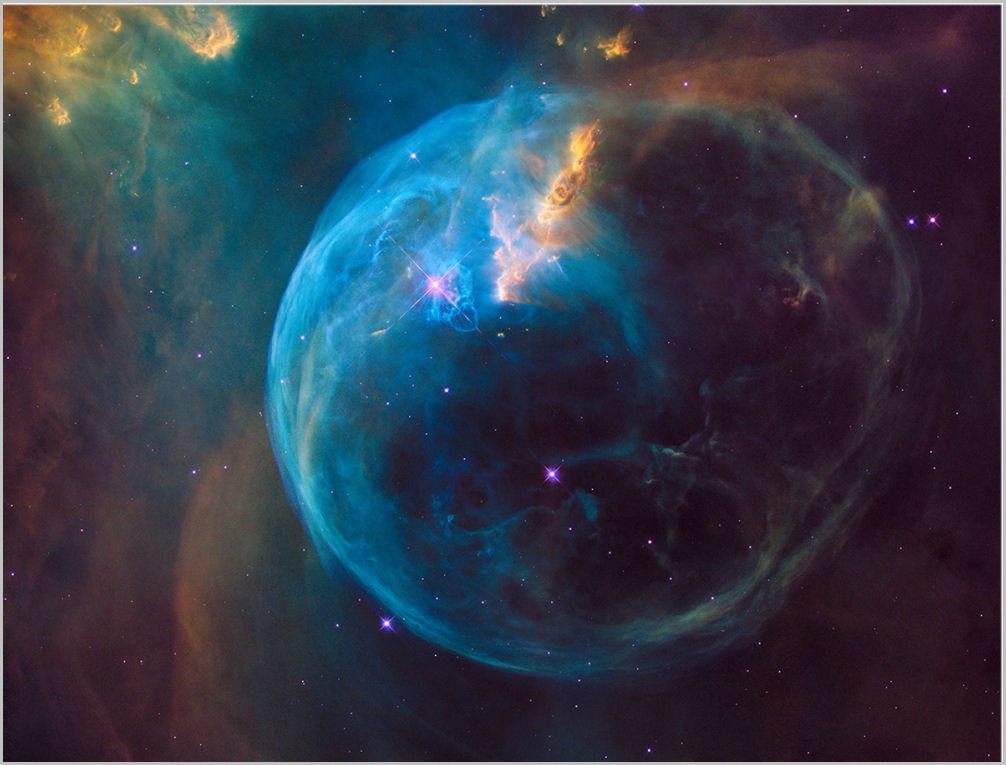
Cassiopeia contains a very special nebula, SN 1572, a remnant of the supernova explosion of 1572, that was actually witnessed by Human eyes. In all of Human history it has only happened five times.
Supernovae are the most powerful explosions in the universe, and they are relatively rare. They are caused by the death of a supermassive star. The light from a supernova explosion is brighter than the combined light of an entire galaxy full of hundreds of billions of stars, and can be seen across the universe from millions of light years away. The initial brilliance of a supernova only lasts for a few weeks or months before fading away, but the immense cloud of expanding gas left behind (the nebula, or supernova remnant), can last for millions of years.
Observations of these remnants suggests that supernovae occur inside our own Milky Way galaxy about once every fifty years, and in all of recorded history there have been only five officially observed and recorded supernovae inside our galaxy. The first was SN 185, witnessed in China in 185 AD in the southern constellation of Circinus. The second was SN 1006, observed in the constellation Lupus, in 1006 AD. The third was SN 1054, observed in the constellation of Taurus, in 1054 AD, which gave rise to Messier's first catalogued "nebula", M1, otherwise known as the Crab Nebula (NGC 1952). Before the fifth and last supernova, SN 1604 (also known as Kepler's Star), was observed in the constellation Ophiuchus in 1604, Milky Way supernova number four SN 1572, occurred right here in the constellation of Cassiopeia, in 1572. The famous astronomer, Tycho Brahe, describes his discovery of the "new" star:
"On the 11th day of November in the evening after sunset, I was contemplating the stars in a clear sky. I noticed that a new and unusual star, surpassing the other stars in brilliancy, was shining almost directly above my head; and since I had, from boyhood, known all the stars of the heavens perfectly, it was quite evident to me that there had never been any star in that place of the sky, even the smallest, to say nothing of a star so conspicuous and bright as this. I was so astonished of this sight that I was not ashamed to doubt the trustworthiness of my own eyes. But when I observed that others, on having the place pointed out to them, could see that there was really a star there, I had no further doubts. A miracle indeed, one that has never been previously seen before our time, in any age since the beginning of the world."
Tycho initiated an in-depth study of the star, before the days of telescopes, publishing his results in his famous De Nova Stella, which included his hand drawn map of the star's position, and resulted in the star being given his name: Tycho's Star. A supernova explosion cannot be predicted, and the serendipity of Tycho's discovery means anyone familiar with the night sky could chance upon a similar sight, and possibly have their name immortalized in the star charts.
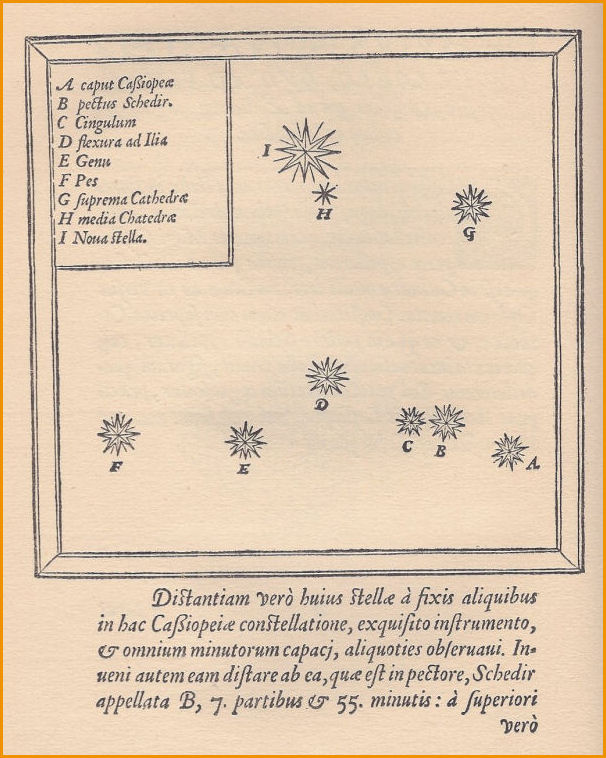
It would take another 400 years after Tycho's sighting before modern telescopes were able to detect the gaseous remnant of the SN 1572 explosion. The photo below is a x-ray infrared composite of the expanding gas cloud caused by the explosion. It is about 7,500 light years away, and expanding at a speed of about 20 million miles per hour.
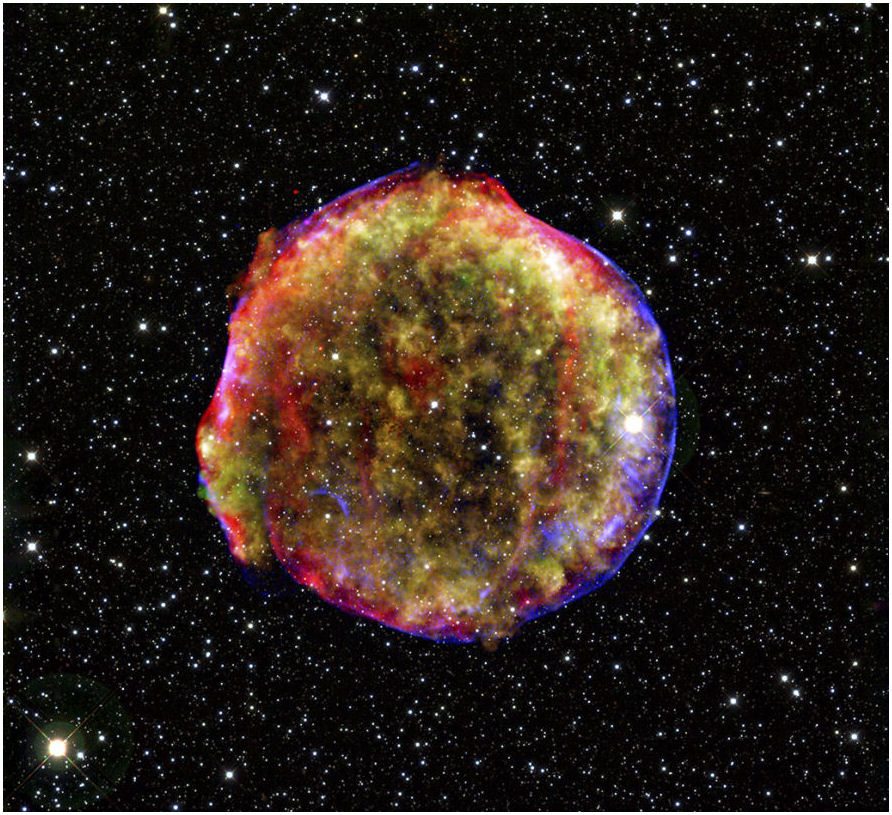
Cassiopeia also contains the youngest supernova remnant so far discovered in our galaxy. Named Cassiopeia A, it is estimated to be 340 years old, but there is no record of anyone observing the supernova explosion that caused it. It is possible the initial material shed from the dying star obscured the final explosion. It is about 10,000 light years away.
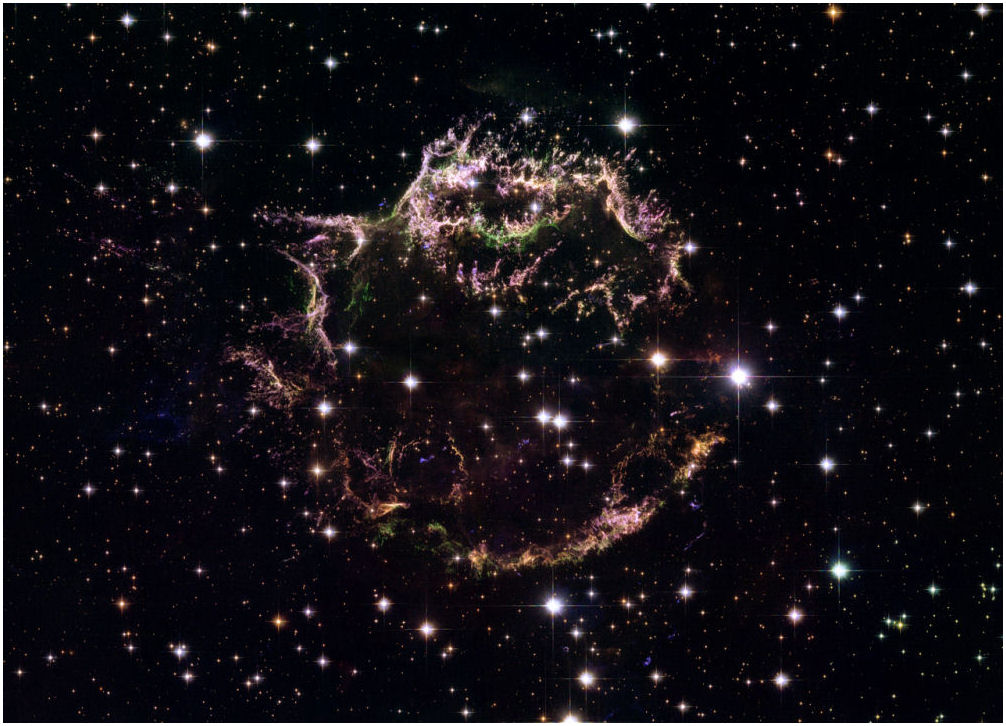
|
|
|
|
|
|